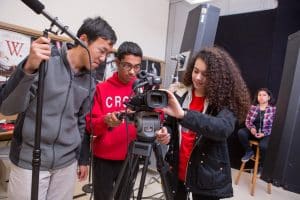WIOA Reauthorization: Federal Policy to Support Work-Based Learning
Education Domain Blog

This past December, the House Education and Workforce Committee Chair Virginia Foxx (R -N.C.) and Ranking Member Bobby Scott (D-V.A.) released and advanced H.R. 6655, “A Stronger Workforce for America Act” (ASWA) to comprehensively update the primary federal investment in workforce development, the Workforce Innovation and Opportunity Act (WIOA). Last updated by Congress in 2014 and due for reauthorization since 2020, WIOA authorizes formula funding for adults, dislocated workers, and youth populations, along with several other workforce development programs and initiatives. These efforts are intended to remove barriers and create opportunities for Americans facing significant education and employment challenges to succeed in the labor market by providing funding for things like training and supportive services needed to secure high-quality careers, as well as supporting efforts to match employers with employees who can meet their needs. Notably, WIOA includes roughly $1 billion annually for youth workforce activities to support young people seeking to enter the workforce and significantly prioritizes those who may be disconnected from traditional schooling.
Work-based learning is a powerful tool for anytime, anywhere learning and plays an important role in transitioning to a competency-based education and workforce development system that recognizes learning beyond the confines of the traditional classroom. Even though the nexus of the work is done within state and local contexts and depends on the economic opportunities and needs of different geographic regions, the federal government plays an important role in shaping work-based learning, particularly through investments authorized by WIOA. ASWA is an encouraging step towards ensuring ongoing support for advancing work-based learning. We found the following improvements in ASWA particularly helpful:
- Promoting skills-based training and hiring. Skills-based hiring means employers are focused on hiring based on the specific skills and competencies needed to perform certain jobs and can result in better matches between employees and employers. Promoting access to skills-based training opportunities can be an effective strategy for preparing more diverse sets of individuals to more effectively communicate what they know and are able to do, which can help to increase for workforce participation and retention rates.
- Supporting data transparency. Supporting digital learning and employment record (LER) infrastructure is an important role federal policy makers can play. ASWA includes helpful language requiring underlying data and information generated by federally funded programs to be expressed in standardized, linkable, open, and interoperable data formats and is the way digital records, like learning and employment records, can be made a reality moving forward.
- Expanding access for youth. ASWA replaces the term “Out-of-School Youth” with “Opportunity Youth.” This expanded definition allows for greater flexibility to reach more youth who may need access to critical resources and training opportunities before becoming disconnected, and would allow for better coordination and alignment with other funding streams that prioritize or target youth populations enrolled in education or training.
- Alignment of Federal Terminology. ASWA helps align different federal terminology related to work-based learning, folding in the Carl D. Perkins Career and Technical Education Act (Perkins V) definition of work-based learning. Terminology alignment is helpful for the field and will be important to ensure the vision for high quality work-based learning can be implemented with fidelity.
While ASWA had many promising provisions, we also have some concerns about the current draft of the bill. One of the most impactful elements of WIOA currently is its ability to provide critical wraparound and supportive services that enable individuals to engage with and complete training experiences successfully. By allowing funding to be used for wrap-around services, including childcare, transportation and to address other barriers that often prevent people from participating in training consistently, WIOA helps to foster greater participation from those most in need. By mandating that increased federal dollars must be used for training, ASWA inadvertently undermines one of WIOA’s biggest benefits. While training is critically important, if people can’t access it, it cannot be impactful.
The recommended funding levels also must be increased to effectively deliver on the promise of supporting the workforce as laid out in ASWA. As structured, the legislation proposes a roughly 3 percent increase over current funding levels for core WIOA programs, despite asking much more from the publicly-funded workforce system. Implementing the proposed provisions with nearly current levels of investment may increase the percentage of WIOA funding spent on training, but may not provide enough support for participants to be successful, particularly with potential decreased access wrap-around supports. Training needs to lead to workforce opportunities in order to benefit both employees and employers.
The Committee’s commitment to youth as part of workforce development is a promising signal of the importance of work-based learning in ASWA. As employers’ needs continue to evolve, particularly as they shift in response to changes in technology like artificial intelligence, training and opportunities for work experience for youth will become increasingly important. We appreciate the work of Chairwoman Foxx and Ranking Member Scott, with the full House and Education Workforce Committee, to advance ASWA and look forward to continued momentum on these important issues.